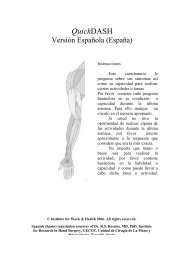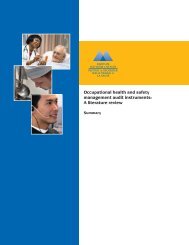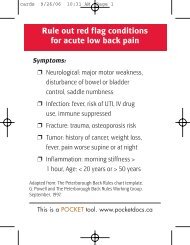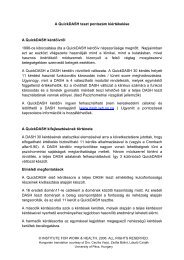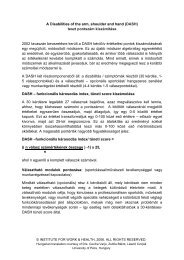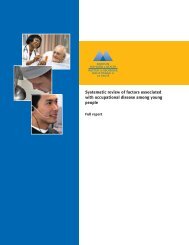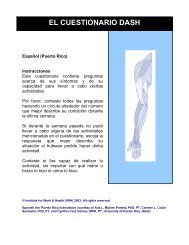A systematic review of injury/illness prevention and loss control ...
A systematic review of injury/illness prevention and loss control ...
A systematic review of injury/illness prevention and loss control ...
- No tags were found...
Create successful ePaper yourself
Turn your PDF publications into a flip-book with our unique Google optimized e-Paper software.
will be quality assessed using both sets <strong>of</strong> criteria. Examples <strong>of</strong> IPC measurement toolstudies are organizational policy <strong>and</strong> practice (OPP) studies <strong>and</strong> those that involveprimarily psychometric analyses (e.g., <strong>and</strong> instrument reliability/validity studies).These studies may be cross-sectional. Our primary focus here will be on measurementtools that have been used to assess IPCs <strong>and</strong> more diagnostic tools like safety climate,safety culture or a st<strong>and</strong>ard set <strong>of</strong> organizational policies or practices – like ergonomicpolicies.a) IPC Measurement Tool Onlyb) IPC Only (Program, Policy or Practice)c) Both IPC Program <strong>and</strong> IPC Measurement Toold) UnclearAll questions following Q2 do not need to be answered if the answer to Q2 is “a”The remaining questions are for IPC studies only. If a study includes both IPCs <strong>and</strong>IPC measurement tools, answer the remaining questions focusing on the IPC portion <strong>of</strong>the study.Q3. Were concurrent comparison groups(s) used? (choose only one answer)A comparison group is important to document <strong>and</strong> account for the potential effects <strong>of</strong>unexpected secular changes. Having a closely analogous referent group, with similarexposure to causal risk factors as the intervention subjects is a major strength <strong>of</strong> aworkplace intervention study. A comparison group can receive a ‘placebo; <strong>and</strong> thus beconsidered a comparison. By ‘concurrent’ it is expected the information on the <strong>control</strong>or comparison group is collected at the same times as the treatment group. Comparisongroups are actual groups <strong>of</strong> individuals; statistically generated references created forcomparison do not constitute a <strong>control</strong>.a) Yes; single referent groupOne comparison group was used against which the intervention’s effect wasevaluated.b) Yes; multiple referent groupsMore than one comparison group was used to evaluate the intervention’s effects.Referents can be within the same plant (such as different departments), or outside theintervention plant (such as a similar company in the same industry, etc.) <strong>and</strong> mayhave received no interventions, or some interventions that differ from those <strong>of</strong> thestudy group.c) Uncleard) No Control or Comparison GroupNo concurrent comparison groups were used in the study.All questions following Q3 do not need to be answered if the answer to Q3 is “d”66 Institute for Work & Health



